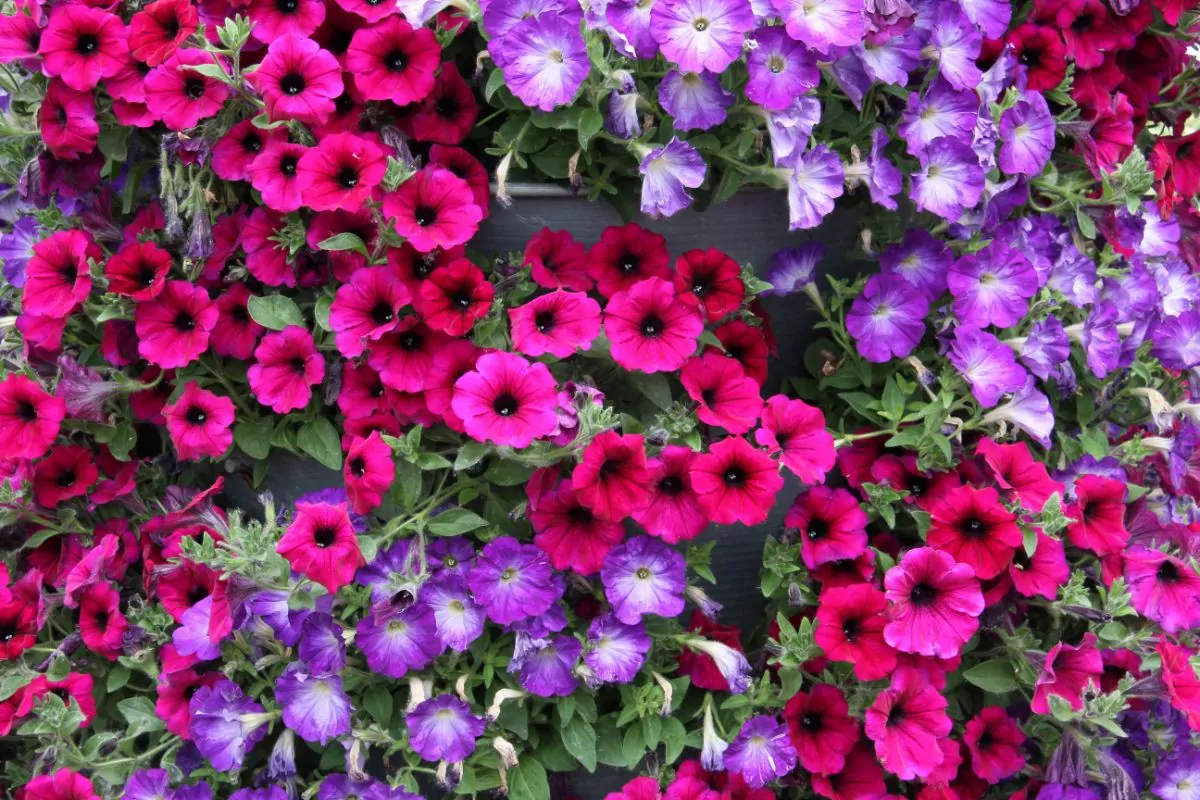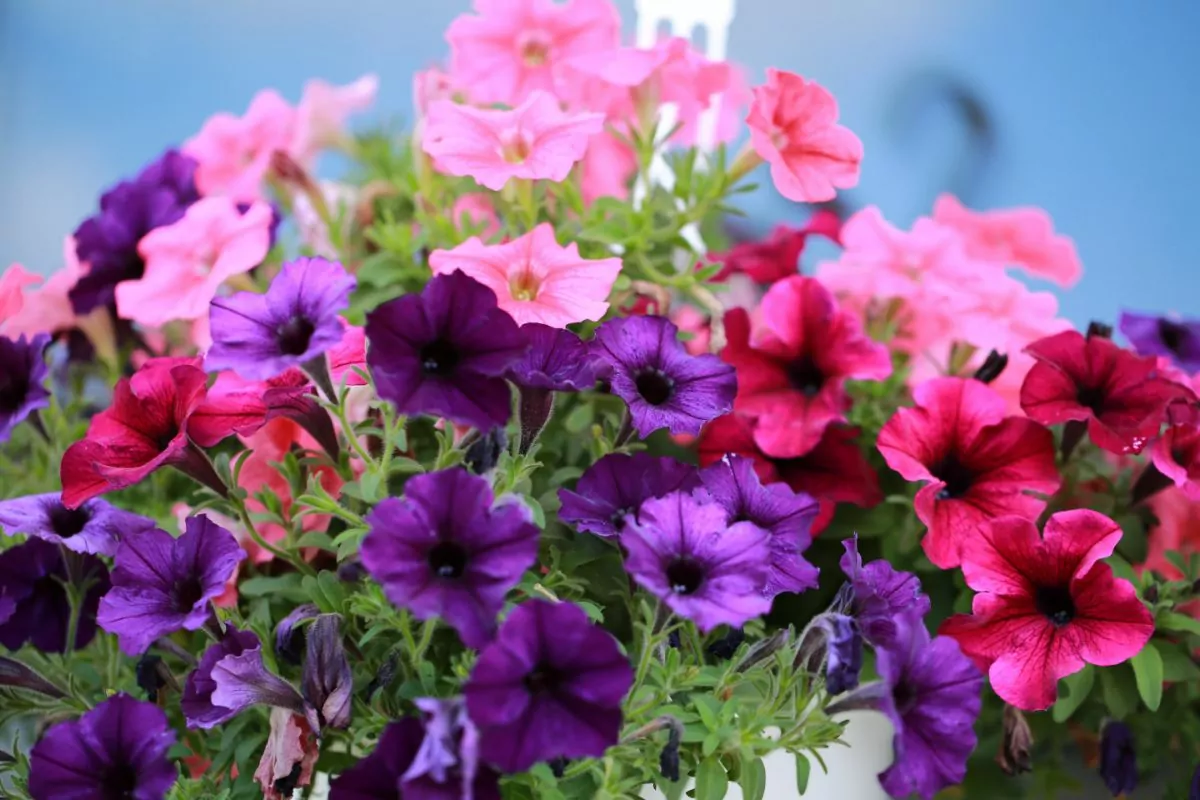Petunias are a popular sight in gardens, as they can add lots of color to garden beds and borders. Gardeners love them, as they are so easy to grow, provided they receive enough water and sunlight.

However, if you are thinking about growing petunias in your backyard, you’ll need to know whether they will need replanting come winter, or if they will keep growing year by year.
So, are petunias perennials or annuals?
In short, petunias can grow as both perennial and annuals, based on the hardiness zone they form in.
We’ll cover more about petunias in this post, including the differences between growing them as annuals and perennials.
What Are Petunias, Perennials, Or Annuals?
Petunias are strictly classed as tender perennials, but as they can’t handle frost, they form as annuals in colder areas.
Petunias are loved in many gardens and are thought to be annuals in a lot of hardiness zones. Many of these can’t handle temperatures under sub-freezing, which is below 40°F.
Petunias are tropical plants that don’t enter a dormancy phase. If they are grown in optimum locations, they will flower constantly between 12 and 18 months.
After all of the flowers are spent, they will die and won’t grow back.
Petunias are known as short-lived perennials in tropical locations. This is why a lot of gardeners view them as annuals, as they foresee replacing them every season.
Petunias can self-seed in the earth, but these often won’t produce enough returning plants.
Petunia Hardiness Zones
As petunias are tropical flowers, they are tender perennials in hardiness zones 10, 11, and over.
These zones are warmer locations found far south and across the southern U.S. coast. Petunias in other locations are thought to be annuals.
Petunia growers can see blooms lasting a year or over in zones 10 and 11. To germinate successfully, their seeds will need a consistent temperature between 70 and 80 °F.
This is why warmer locations can enjoy as many as 18 months of beautiful petunia blooms.
Petunias can form in colder areas, but these will be annuals. For the plants to do well in a garden, night temperatures will not be able to fall under 55°F.
Daytime temperatures will also need to stay at 65°F or over.
The blooming plant’s life cycle is affected by temperature and the sun. Warmer temperatures can increase the plant’s lifespan and flowering cycle.
This is the opposite in colder areas, as the petunias only last a single season.
Do Petunias Have A Dormancy Phase?
No, petunias do not experience a proper dormancy stage. If they grow as annuals, their life cycles won’t be long enough. This is also the case when growing these plants as perennials.
A plant’s dormant stage usually happens in wintertime, as it sleeps for several months. The plant uses this period to accumulate nutrients needed for growth.
Dormancy symptoms include foliage falling off, while some plants die and return to the earth. All that’s left are the roots that remain undamaged in the soil.
As petunias are relatively available and affordable, many growers choose to treat them like annuals.
They anticipate replacing the plants every spring, but if you have a pricier petunia species, you may want to consider overwintering.
As petunias are tropical and have shallow roots, you won’t be able to install protective features in your backyard.
Thick amounts of mulch won’t be able to insulate the roots against the temperatures, as they form near the soil’s surface.
Overwintering can help with this. This involves protecting the plants from frosty conditions in a sheltered location, like your garage, basement, or a colder room in your home.
We’ll cover overwintering more in the next section.
Overwintering Petunias
If you want to keep your petunias living through winter, you can overwinter them by taking them inside.
This comes with a few drawbacks, as you can’t overwinter plants grown in the ground. The petunias will receive a strong shock when they are taken from the soil and transplanted in an indoor container.
If you plant petunias in pots, you can easily move the containers indoors when cooler conditions strike.
It’s advised to trim the petunia back before you take it inside. Cutting it to roughly two inches above the soil can help it grow healthy during spring.
Always water your pot before you take it in a dark, cool space. No matter where you overwinter the plant, ensure that the temperatures remain higher than sub-freezing.
You should also dampen the first soil layer every three to four weeks. This will give the petunias enough water to stay alive, but not so much that they begin growing.
This is like pushing the petunias into an artificial dormancy stage.
Based on how much space you have available, you may want to overwinter petunias through cuttings. These cuttings can root well, but make sure you obtain them before the beginning frost.
Just a light amount of frost is enough to destroy petunias.
Growing Perennial Petunias
Perennial gardens have an advantage as their plants will keep returning, year after year. The plants are also more affordable, as you don’t need to purchase new ones every spring.

Petunias can develop as perennials in particular climates.
They do best in areas with warmer winters and summer temperatures that remain under 90°F. Higher temperatures can make the petunia plant burn, making it wilt.
It’s best to plant perennial petunias during fall. The plants will keep generating blooms until the summer conditions become too hot. If the summers are quite cool, the plant will keep flowering.
Petunias prefer full sunlight, as they can turn spindly when they don’t receive enough. Poor sunlight can affect blooming, as the flowers become smaller and less abundant.
The flowering period also becomes much shorter.
A few growers may begin their petunias with seed, but this is very difficult. Petunias have very small seeds that can quickly go missing.
These seeds also need particular temperatures for optimum germination, but this may vary depending on your location.
It’s best to start petunia seeds inside, roughly two months before the final frost. Allow the soil to warm up for an extra two weeks before you plant the petunia seedlings.
Growing Annual Petunias
Petunias are usually grown as annuals for one reason, which is related to temperature sensitivity. As they are tropical, petunias don’t like hot or cold temperatures.
This affects the locations where they can form as perennials. It also takes a lot of effort to overwinter less expensive plants.
The way you grow petunias varies based on your location’s climate. If you live in a cooler area, plant your petunias during spring. Always wait until the risk of frost has gone by.
Petunia annuals will normally bloom between late spring and fall, provided summer temperatures remain under 90°F.
If you live in a warmer area, growers tend to plant petunias during fall. Rather than waiting for the frost risk to pass, petunia growers are searching for indications of dropping temperatures.
These plants will flower in warmer conditions in fall, winter, and spring, then die out once the hot summer temperatures return.
Annual petunias and perennial petunias will need the same growing conditions. Both of these require six hours of full sun, minimum. If annual petunias are grown in the shade, they may not produce any flowers.
You can extend the blooming period’s length by trimming dead flowers off of the plants. This also ensures they retain their beautiful, bushy, form.
Final Thoughts
Petunias are colorful plants that are often used to brighten up gardens. These are classed as tender perennials, but they are very temperature-sensitive, which is why they are usually grown as annuals.
People may grow petunias as annuals, but as they are perennials, you can obtain petunia cuttings during summer.
If these cuttings are overwintered in the right conditions, they can produce new blooms during the next year.
We hope you enjoyed learning about petunias and consider planting them in your backyard!
- Interesting Flowers That Start With A - July 21, 2023
- Interesting Flowers Beginning With H - July 21, 2023
- 14 Fascinating Flowers That Begin With C - July 20, 2023
